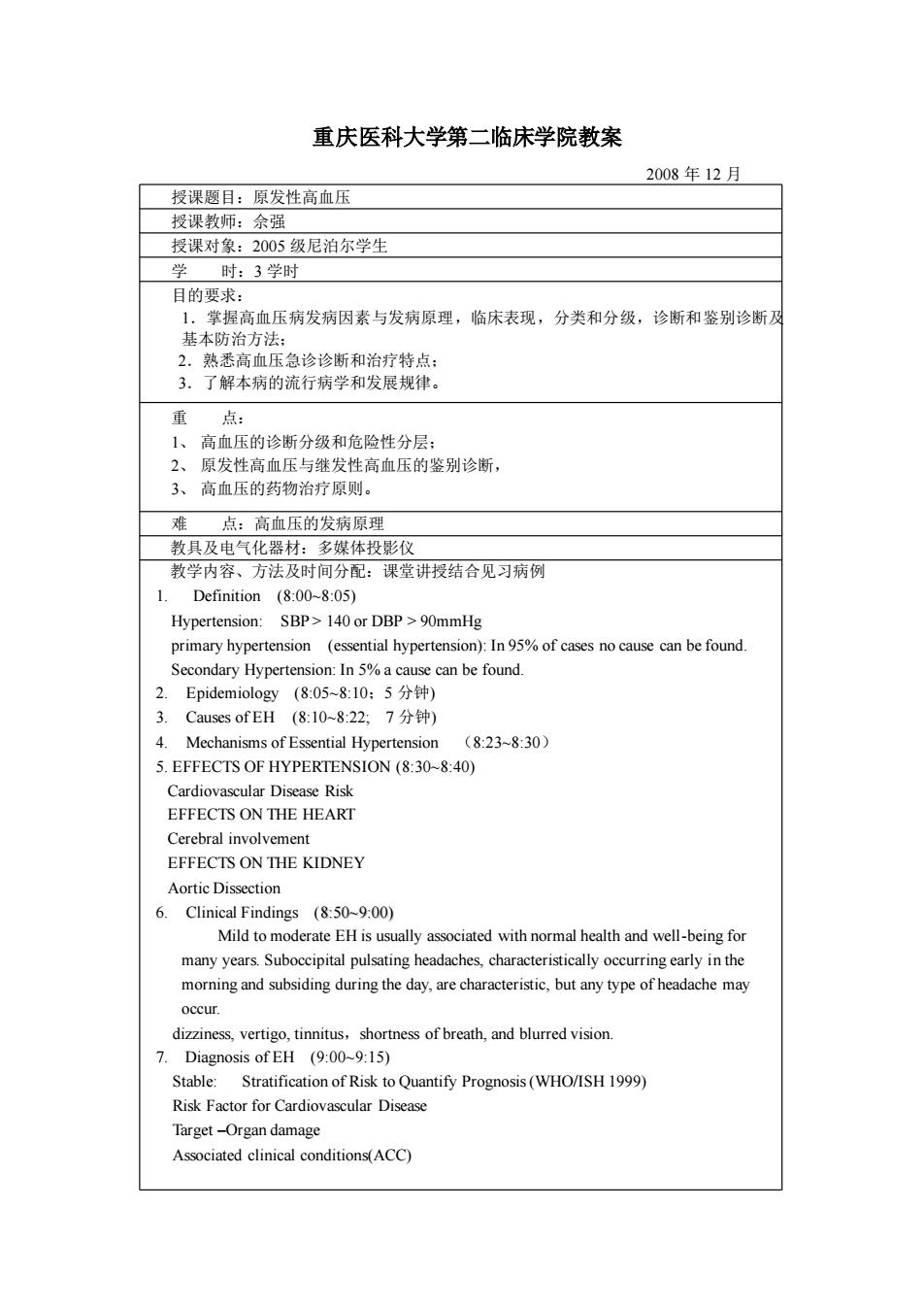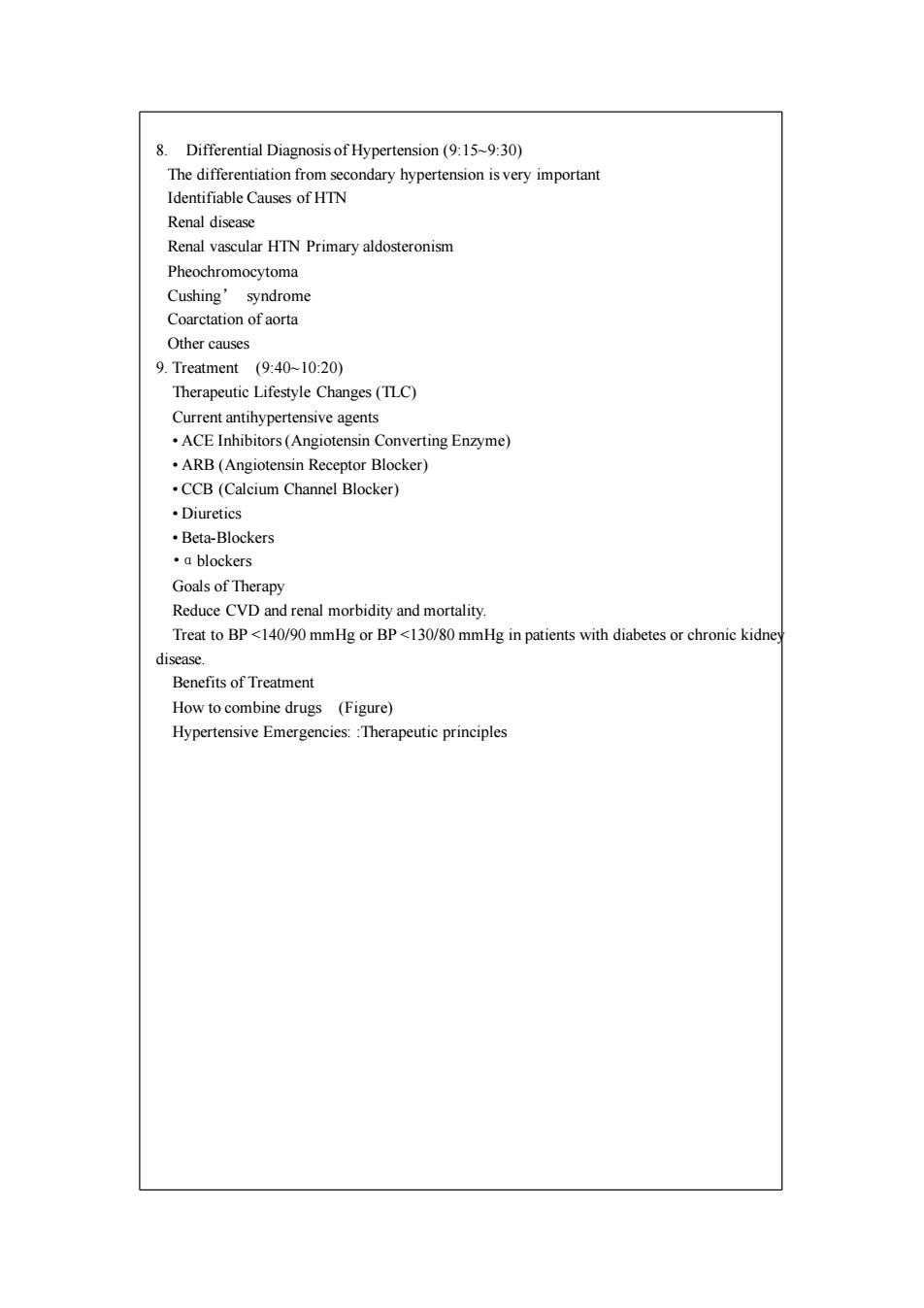
重庆医科大学第二临床学院教案 2008年12月 授课题目:原发性高血压 授课教师:余强 授课对象:2005级尼泊尔学生 25 时:3学时 目的要求 高血压病发病因素与发病原理,临床表现,分类和分级,诊断和鉴别诊断 熟悉高血压急诊诊和治疗特点: 3. 了解本病的流行病学和发展规律 重 点 【、高血压的诊断分级和危险性分层: 2、原发性高血压与继发性高血压的鉴别诊断, 3、高血压的药物治疗原则。 难点:高血压的发病原理 教且及申气化黑材:多媒体投影仪 教学内容、 方法及时间分配 课堂讲授结合见习病例 Definition (00-8:05) Hypertension:SBP>140 or DBP>90mmHg primary hypertension (essential hypertension):In95%of cases no cause can be found. Secondary Hypertension In 5%a cause can he found 8-05810.5分钟) 3. Causes ofEH (810822 7分钟) 4.Mechanisms of Essential Hypertension (8:23~8:30) 5.EFFECTS OF HYPERTENSION (8:30-8:40) Cardiovascular Disease Risk EFFECTS ON THE HEART Cerebral involvement EFFECTS ON THE KIDNEY Aortic Dissection 6.Clinical Findings (8:50-9-00) Mild to moderate EH is usually assciated with normal health and well-being for morning and subsiding during the day,are characteristic,but any type of headache may occur. dizziness.vertigo.tinnitus,shortness of breath.and blurred vision. 7.Diagnosis of EH (9:00-9:15) Stable Stratificati Risk Factor for Cardiovascular Disease Target-Organ damage Associated clinical conditions(ACC)
重庆医科大学第二临床学院教案 2008 年 12 月 授课题目:原发性高血压 授课教师:佘强 授课对象:2005 级尼泊尔学生 学 时:3 学时 目的要求: 1.掌握高血压病发病因素与发病原理,临床表现,分类和分级,诊断和鉴别诊断及 基本防治方法; 2.熟悉高血压急诊诊断和治疗特点; 3.了解本病的流行病学和发展规律。 重 点: 1、 高血压的诊断分级和危险性分层; 2、 原发性高血压与继发性高血压的鉴别诊断, 3、 高血压的药物治疗原则。 难 点:高血压的发病原理 教具及电气化器材:多媒体投影仪 教学内容、方法及时间分配:课堂讲授结合见习病例 1. Definition (8:00~8:05) Hypertension: SBP > 140 or DBP > 90mmHg primary hypertension (essential hypertension): In 95% of cases no cause can be found. Secondary Hypertension: In 5% a cause can be found. 2. Epidemiology (8:05~8:10;5 分钟) 3. Causes of EH (8:10~8:22; 7 分钟) 4. Mechanisms of Essential Hypertension (8:23~8:30) 5. EFFECTS OF HYPERTENSION (8:30~8:40) Cardiovascular Disease Risk EFFECTS ON THE HEART Cerebral involvement EFFECTS ON THE KIDNEY Aortic Dissection 6. Clinical Findings (8::50~9::00) Mild to moderate EH is usually associated with normal health and well-being for many years. Suboccipital pulsating headaches, characteristically occurring early in the morning and subsiding during the day, are characteristic, but any type of headache may occur. dizziness, vertigo, tinnitus,shortness of breath, and blurred vision. 7. Diagnosis of EH (9:00~9:15) Stable: Stratification of Risk to Quantify Prognosis (WHO/ISH 1999) Risk Factor for Cardiovascular Disease Target –Organ damage Associated clinical conditions(ACC)

8.Differential Diagnosisof Hypertension(9:159:30) Renal disease Renal vascular HTN Primary aldosteronism Pheochromocytoma Cushing syndrome Coarctation of aorta Other causes 9.Treatment(9:40-10:20) Therapeutic Lifestyle Changes (TLC) .ARB(Angiotensin Receptor Blocker) .CCB(Calcium Channel Blocker) .Diuretics .Beta-Blockers Goals of Therapy Reduce CVD and renal morbidity and mortality. Treat to BP<140/90 mmHg or BP<130/80 mmHg in patients with diabetes or chronic kidne disease Benefits of Treatment How to combine drugs (Figure) Hypertensive Emergencies::Therapeutic principles
8. Differential Diagnosis of Hypertension (9:15~9:30) The differentiation from secondary hypertension is very important Identifiable Causes of HTN Renal disease Renal vascular HTN Primary aldosteronism Pheochromocytoma Cushing’ syndrome Coarctation of aorta Other causes 9. Treatment (9:40~10:20) Therapeutic Lifestyle Changes (TLC) Current antihypertensive agents • ACE Inhibitors (Angiotensin Converting Enzyme) • ARB (Angiotensin Receptor Blocker) • CCB (Calcium Channel Blocker) • Diuretics • Beta-Blockers •αblockers Goals of Therapy Reduce CVD and renal morbidity and mortality. Treat to BP <140/90 mmHg or BP <130/80 mmHg in patients with diabetes or chronic kidney disease. Benefits of Treatment How to combine drugs (Figure) Hypertensive Emergencies: :Therapeutic principles